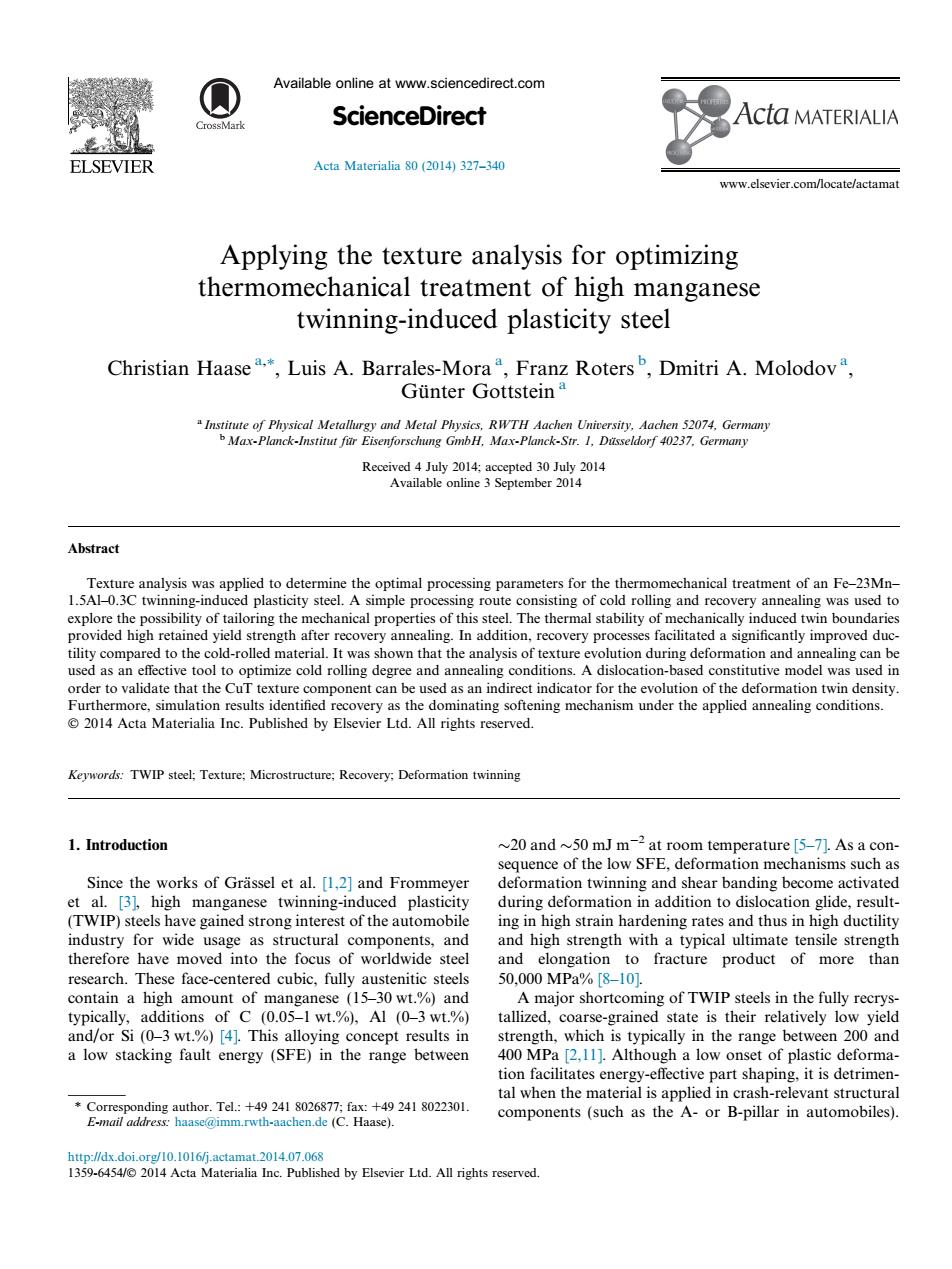正在加载图片...

Available online at www.sciencedirect.com CrossMark ScienceDirect ACta MATERIALIA ELSEVIER Acta Materialia 80(2014)327-340 www.elsevier.com/locate/actamat Applying the texture analysis for optimizing thermomechanical treatment of high manganese twinning-induced plasticity steel Christian Haase*,Luis A.Barrales-Mora,Franz Roters,Dmitri A.Molodov", Gunter Gottstein A Institute of Physical Metallurgy and Metal Physics,RWTH Aachen University,Aachen 52074,Germany Max-Planck-Institut fur Eisenforschung GmbH.Max-Planck-Str.1.Dusseldorf 40237.Germany Received 4 July 2014;accepted 30 July 2014 Available online 3 September 2014 Abstract Texture analysis was applied to determine the optimal processing parameters for the thermomechanical treatment of an Fe-23Mn- 1.5Al-0.3C twinning-induced plasticity steel.A simple processing route consisting of cold rolling and recovery annealing was used to explore the possibility of tailoring the mechanical properties of this steel.The thermal stability of mechanically induced twin boundaries provided high retained yield strength after recovery annealing.In addition,recovery processes facilitated a significantly improved duc- tility compared to the cold-rolled material.It was shown that the analysis of texture evolution during deformation and annealing can be used as an effective tool to optimize cold rolling degree and annealing conditions.A dislocation-based constitutive model was used in order to validate that the CuT texture component can be used as an indirect indicator for the evolution of the deformation twin density. Furthermore,simulation results identified recovery as the dominating softening mechanism under the applied annealing conditions. 2014 Acta Materialia Inc.Published by Elsevier Ltd.All rights reserved. Keywords:TWIP steel;Texture;Microstructure;Recovery;Deformation twinning 1.Introduction ~20 and ~50 mJ m-2 at room temperature [5-71.As a con- sequence of the low SFE,deformation mechanisms such as Since the works of Grassel et al.[1,2]and Frommeyer deformation twinning and shear banding become activated et al.[3],high manganese twinning-induced plasticity during deformation in addition to dislocation glide,result- (TWIP)steels have gained strong interest of the automobile ing in high strain hardening rates and thus in high ductility industry for wide usage as structural components,and and high strength with a typical ultimate tensile strength therefore have moved into the focus of worldwide steel and elongation to fracture product of more than research.These face-centered cubic,fully austenitic steels 50,000MPa%[8-101. contain a high amount of manganese (15-30 wt.%)and A major shortcoming of TWIP steels in the fully recrys- typically,additions of C (0.05-1 wt.%),Al (0-3 wt.%) tallized,coarse-grained state is their relatively low yield and/or Si (0-3 wt.%)[4].This alloying concept results in strength,which is typically in the range between 200 and a low stacking fault energy(SFE)in the range between 400 MPa [2,11].Although a low onset of plastic deforma- tion facilitates energy-effective part shaping,it is detrimen- tal when the material is applied in crash-relevant structural Corresponding author.Tel.:+49 241 8026877:fax:+49 241 8022301. components(such as the A-or B-pillar in automobiles). E-mail address:haase@imm.rwth-aachen.de (C.Haase). http://dx.doi.org/10.1016/j.actamat.2014.07.068 1359-6454/2014 Acta Materialia Inc.Published by Elsevier Ltd.All rights reserved.Applying the texture analysis for optimizing thermomechanical treatment of high manganese twinning-induced plasticity steel Christian Haase a,⇑ , Luis A. Barrales-Mora a , Franz Roters b , Dmitri A. Molodov a , Gu¨nter Gottstein a a Institute of Physical Metallurgy and Metal Physics, RWTH Aachen University, Aachen 52074, Germany bMax-Planck-Institut fu¨r Eisenforschung GmbH, Max-Planck-Str. 1, Du¨sseldorf 40237, Germany Received 4 July 2014; accepted 30 July 2014 Available online 3 September 2014 Abstract Texture analysis was applied to determine the optimal processing parameters for the thermomechanical treatment of an Fe–23Mn– 1.5Al–0.3C twinning-induced plasticity steel. A simple processing route consisting of cold rolling and recovery annealing was used to explore the possibility of tailoring the mechanical properties of this steel. The thermal stability of mechanically induced twin boundaries provided high retained yield strength after recovery annealing. In addition, recovery processes facilitated a significantly improved ductility compared to the cold-rolled material. It was shown that the analysis of texture evolution during deformation and annealing can be used as an effective tool to optimize cold rolling degree and annealing conditions. A dislocation-based constitutive model was used in order to validate that the CuT texture component can be used as an indirect indicator for the evolution of the deformation twin density. Furthermore, simulation results identified recovery as the dominating softening mechanism under the applied annealing conditions. 2014 Acta Materialia Inc. Published by Elsevier Ltd. All rights reserved. Keywords: TWIP steel; Texture; Microstructure; Recovery; Deformation twinning 1. Introduction Since the works of Gra¨ssel et al. [1,2] and Frommeyer et al. [3], high manganese twinning-induced plasticity (TWIP) steels have gained strong interest of the automobile industry for wide usage as structural components, and therefore have moved into the focus of worldwide steel research. These face-centered cubic, fully austenitic steels contain a high amount of manganese (15–30 wt.%) and typically, additions of C (0.05–1 wt.%), Al (0–3 wt.%) and/or Si (0–3 wt.%) [4]. This alloying concept results in a low stacking fault energy (SFE) in the range between 20 and 50 mJ m2 at room temperature [5–7]. As a consequence of the low SFE, deformation mechanisms such as deformation twinning and shear banding become activated during deformation in addition to dislocation glide, resulting in high strain hardening rates and thus in high ductility and high strength with a typical ultimate tensile strength and elongation to fracture product of more than 50,000 MPa% [8–10]. A major shortcoming of TWIP steels in the fully recrystallized, coarse-grained state is their relatively low yield strength, which is typically in the range between 200 and 400 MPa [2,11]. Although a low onset of plastic deformation facilitates energy-effective part shaping, it is detrimental when the material is applied in crash-relevant structural components (such as the A- or B-pillar in automobiles). http://dx.doi.org/10.1016/j.actamat.2014.07.068 1359-6454/ 2014 Acta Materialia Inc. Published by Elsevier Ltd. All rights reserved. ⇑ Corresponding author. Tel.: +49 241 8026877; fax: +49 241 8022301. E-mail address: haase@imm.rwth-aachen.de (C. Haase). www.elsevier.com/locate/actamat Available online at www.sciencedirect.com ScienceDirect Acta Materialia 80 (2014) 327–340�����